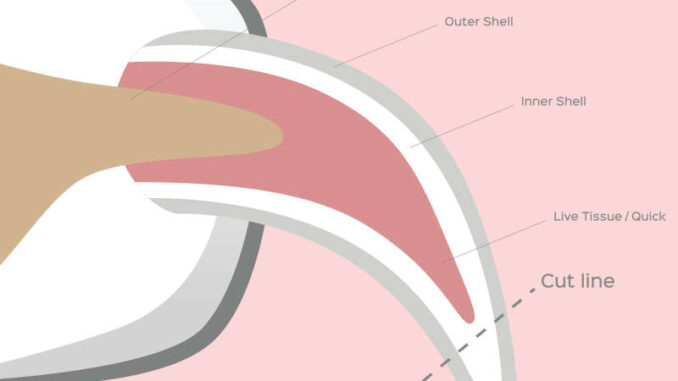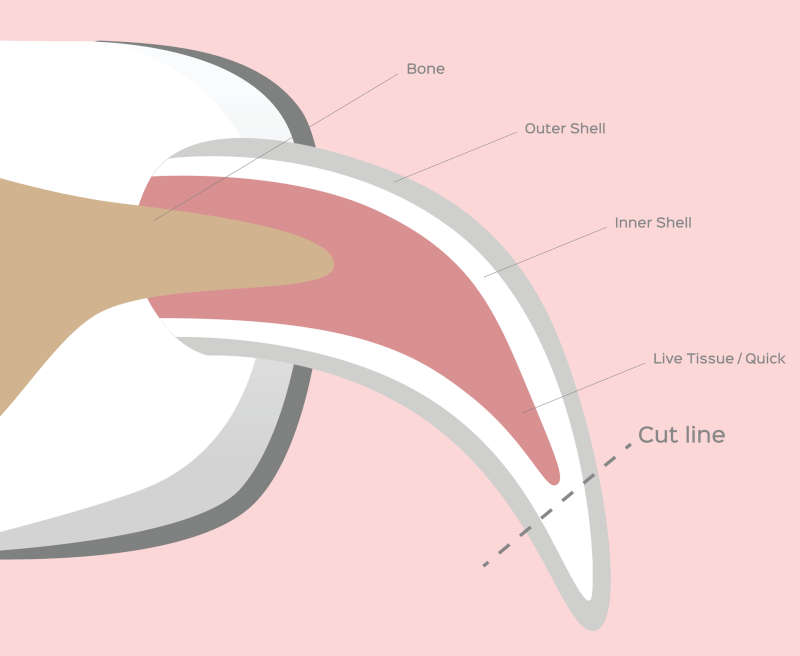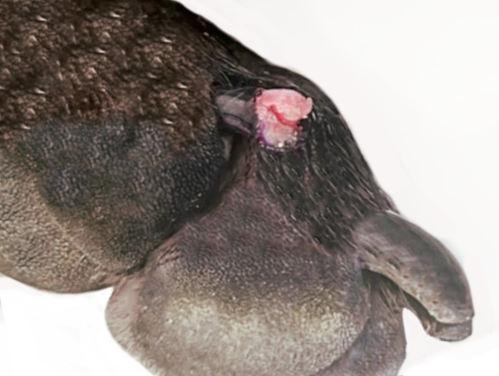
Torn toenails are an issue that I encounter on a relatively regular basis. Sometimes, these dogs are accompanied by panicked owners. They may have seen their dog cry out in pain, then noticed immediate bleeding from an injured or torn toenail. Other times, the owners don’t know that the toenail is torn. They may bring their dog in for excessive licking at the paws, and the torn toenail is found only on close inspection by the veterinarian or veterinary technician.
Regardless of how a dog with a torn toenail presents, the condition is uncomfortable and it can lead to more significant problems down the road. Don’t ignore a torn toenail; this condition requires treatment.
Read on to learn more about torn toenails and dog toenails that have separated from the quick, including how to identify this condition and how it should be treated.
Dog Toenail Anatomy
When you look at your own fingernails or toenails, you see a hard nail, made of keratin. Under the nail, you can see a soft, sensitive nail bed or “quick.” A dog’s toenail is similar to our nails, with some slight differences.
A dog’s hard, visible toenail is made of keratin, just like our nails. However, instead of laying on top of the nail bed, a dog’s toenail completely surrounds a protrusion of sensitive, living tissue that is known as “the quick.”

If you trim your dog’s toenails at home, you are likely familiar with the need to avoid hitting your dog’s quick. Accidentally cutting the quick of your dog’s nail can cause significant pain, as well as a surprising amount of bleeding.
Just like a dog’s quick can be injured with aggressive nail trimming, injuries can also occur if the toenail itself becomes injured. A long toenail that becomes caught on something can become broken, separating from the quick in the process. This causes significant discomfort for the dog.
Signs of a Broken Toenail or Exposed Quick
The signs of a broken or injured toenail can vary significantly.
In some cases, you may see your dog cry out in pain when the toenail injury occurs. You might also notice bleeding from the toenail, and your dog may lick the affected area. On closer examination, you may notice that a portion of the toenail is missing and there is blood on and around the quick.

If you aren’t around to see the initial injury to the toenail, the signs may be more subtle. You might notice that your dog is limping, holding up the affected paw, or licking the paw excessively. When you look more closely, you may notice that all or part of the toenail is missing. You also may be able to see the exposed quick. The quick is a fleshy protrusion from the end of the toe, and it may vary from pink to black in color. If you accidentally touch the quick of the toenail, your dog will likely react with pain. (Be careful – the pain may be severe enough to cause your dog to bite!)
Does a toenail that has separated from the quick require veterinary treatment?
If your dog has a torn toenail that has resulted in an exposed quick, your dog will need veterinary treatment.
An exposed quick is painful for your dog and can become infected. Prompt veterinary care can minimize your dog’s discomfort and prevent infection.
Can a broken toenail be an emergency?
Fortunately, a torn toenail is rarely a life-threatening emergency. Even if the toenail is actively bleeding, you can control most bleeding at home. If needed, contact your veterinarian or an emergency veterinary hospital for guidance.
In most cases, a broken toenail can wait a day or two to be seen by your veterinarian during their next available appointment opening. However, in the unlikely event that your dog’s toenail continues bleeding heavily for more than 30 minutes, your dog is in extreme pain, or you notice that your dog’s gums are becoming pale, you should seek emergency veterinary care immediately.
5 Steps if Your Dog’s Nail is Separated from the Quick
The following steps will help you address your dog’s injured nail:
- Keep your dog calm and stationary. It’s only human nature to become a bit panicked when you notice bleeding from your dog’s toenail. Unfortunately, your anxiety will make your dog more excited and agitated. This excitement causes an increase in blood pressure, which may make the exposed quick more likely to bleed. Additionally, an exposed quick can easily be further injured with activity. So, take a deep breath and calm yourself and your dog.
- Stop any bleeding. If your dog’s exposed quick is bleeding, apply a commercially-available dog styptic powder (such as Kwik Stop®) to the affected area to control the bleeding. If you don’t have styptic powder available, you can also press a small amount of flour or cornstarch on the nail quick to stop the bleeding.
- Contact your veterinarian. A torn toenail requires veterinary care. Call your veterinarian and arrange to bring your dog in for treatment. Your vet may ask about your dog’s toenail and your dog’s overall condition, to determine whether the condition warrants an emergency visit or can be seen as a regularly-scheduled appointment. In most cases, it will be okay to wait for your veterinarian’s next available appointment slot for treatment. If your veterinarian considers your dog’s torn toenail to be an emergency, you will be instructed on when and where to have your dog treated. (This may be at your regular veterinary clinic, or you may be referred to a veterinary emergency hospital.)
- Take your dog to the veterinarian for treatment. Your veterinarian will first trim away any free-hanging nail fragments, to prevent further pain and aggravation of the area. Next, your veterinarian will clean your dog’s paw and disinfect the exposed quick. Finally, your veterinarian will apply a bandage to protect the exposed quick from further trauma and from bacterial contamination. Depending on your dog’s temperament, your veterinarian may recommend sedation to avoid causing excessive stress to your dog during this treatment.
- Follow your veterinarian’s recommendations regarding home care and follow up visits. Your veterinarian will likely prescribe pain medications and antibiotics. Give these medications as directed, and watch for side effects as directed by your veterinarian. Keep your dog’s bandage clean and dry. Use a waterproof bootie if your dog must walk through wet areas while the paw is bandaged. Your dog may need to return to the veterinarian for bandage changes and/or a recheck appointment.
Ensuring that your dog receives appropriate treatment for a separated toenail and exposed quick will minimize their discomfort and reduce the risk of complications that may require further treatment.
Is my dog in pain due to the toenail separating from the quick?
A torn toenail is painful for dogs. After all, think of how much it would hurt if your fingernail or toenail was torn off, leaving behind an exposed nail bed!
Fortunately, the pain associated with a torn toenail is not permanent. Most dogs begin to act less painful within a few days, as the damaged quick begins to heal. Over the next several weeks, the nail will begin to regrow. Eventually, the quick will be thoroughly protected by a new nail and all signs of pain will resolve.
How long does it take for a dog’s nail to grow back after separation from the quick?
The time that it takes for a nail to regrow can vary, based upon your dog’s age, nutritional status, and overall health status. In general, however, the nail will regrow within one to two months.
What can go wrong if I don’t treat my dog’s broken nail?
Failing to treat your dog’s broken nail is painful for your dog. Pain medications can provide some quick relief from the pain of an exposed nail bed; withholding these pain medications means that your dog will be in for a very uncomfortable few weeks.
Even more important, however, is the risk of infection. Nail beds are exposed to the dirt every time your dog walks outside, and a broken toenail often triggers dogs to lick at the exposed quick. These factors combine to create a high risk of infection in broken toenails. Infection can be uncomfortable for your dog, and it can also delay or even prevent healing. In some cases, nail bed infections can spread to the bone, causing even more serious problems.
What causes broken toenails, and can I prevent this problem?
Broken toenails are more common in dogs with long nails. The best prevention is regular nail trims. You can learn to perform these nail trims at home, or take your dog to a trusted groomer or your veterinarian for regular nail trims. By keeping your dog’s nails short and healthy, you can reduce the risk of torn toenails.
Torn toenails can also be caused by another underlying condition. For example, an autoimmune condition called lupoid onychodystrophy can cause a dog’s nails to break or fall off very easily. While this condition is uncommon, your veterinarian may begin to suspect it if your dog repeatedly suffers from torn or broken toenails. In this case, your veterinarian may recommend further diagnostics tests and additional treatments.
Disclaimer: This website's content is not a substitute for veterinary care. Always consult with your veterinarian for healthcare decisions. Read More.


My dogs quick separated sideways from her nail. We cleaned, treated and bandaged it, while also keeping it protected from moisture.
My question is: when the nail grows back over the quick, will it push the nail off? Her nail did not rip off, so it will looks like a normal nail, just a small tear on the side where the quick came out. Do I need to trim it, and if so when can I do this without it being a problem. Thanks so much